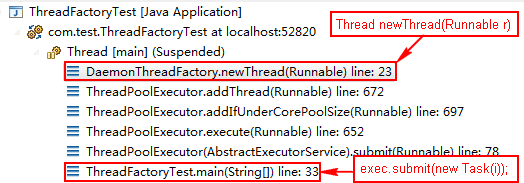根据需要创建新线程的对象。使用线程工厂就无需再手工编写对 new Thread 的调用了,从而允许应用程序使用特殊的线程子类、属性等等。
JDK中的介绍:
An object that creates new threads on demand. Using thread factories removes hardwiring of calls tonew Thread, enabling applications to use special thread subclasses, priorities, etc.
The simplest implementation of this interface is just:
class SimpleThreadFactory implements ThreadFactory {
public Thread newThread(Runnable r) {
return new Thread(r);
}
}Executors.defaultThreadFactory method provides a more useful simple implementation, that sets the created thread context to known values before returning it.
/**
* The default thread factory
*/
static class DefaultThreadFactory implements ThreadFactory {
static final AtomicInteger poolNumber = new AtomicInteger(1);
final ThreadGroup group;
final AtomicInteger threadNumber = new AtomicInteger(1);
final String namePrefix;
DefaultThreadFactory() {
SecurityManager s = System.getSecurityManager();
group = (s != null)? s.getThreadGroup() :
Thread.currentThread().getThreadGroup();
namePrefix = "pool-" +
poolNumber.getAndIncrement() +
"-thread-";
}
public Thread newThread(Runnable r) {
Thread t = new Thread(group, r,
namePrefix + threadNumber.getAndIncrement(),
0);
if (t.isDaemon())
t.setDaemon(false);
if (t.getPriority() != Thread.NORM_PRIORITY)
t.setPriority(Thread.NORM_PRIORITY);
return t;
}
}下面写一简单示例。
package com.test;
import java.util.concurrent.ExecutorService;
import java.util.concurrent.Executors;
import java.util.concurrent.ThreadFactory;
class Task implements Runnable{
int taskId;
public Task(int taskId) {
this.taskId=taskId;
}
@Override
public void run() {
System.out.println(Thread.currentThread().getName()+"--taskId: "+taskId);
}
}
class DaemonThreadFactory implements ThreadFactory {
@Override
public Thread newThread(Runnable r) {
Thread t=new Thread(r);
t.setDaemon(true);
return t;
}
}
public class ThreadFactoryTest {
public static void main(String[] args) {
ExecutorService exec=Executors.newFixedThreadPool(3,new DaemonThreadFactory());
for(int i=0;i<3;i++) {
exec.submit(new Task(i));
}
exec.shutdown();
}
}
输出如下:
Thread-0--taskId: 0
Thread-1--taskId: 1
Thread-2--taskId: 2
Thread-1--taskId: 1
Thread-2--taskId: 2
分析:
DaemonThreadFactory中覆写的newThread()方法与submit()方法的调用关系,也就是说
DaemonThreadFactory是如何起作用的。
调试输出其调用关系:

也就是说,submit()时会调用DaemonThreadFactory类的newThread()方法来创建线程。





















 6142
6142











 被折叠的 条评论
为什么被折叠?
被折叠的 条评论
为什么被折叠?








